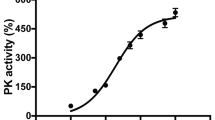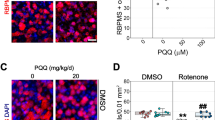Abstract
Damage to mitochondria is a common mechanism of cell death in inherited neurodegenerative disorders. Therefore, mitochondrial protection and mitochondrial repair are promising strategies to induce retinal neuroprotection. Peroxisome proliferator-activated receptor γ coactivator-α (PGC-1α) and β (PGC-1β) are transcriptional coactivators that are the main regulators of mitochondrial biogenesis. We propose that PGC-1α and PGC-1β could play a role in regulating retina cell survival, and may be important therapeutic targets to prevent retinal degeneration.
The original version of this chapter was revised. An erratum to this chapter can be found at DOI10.1007/978-3-319-17121-0_107
An erratum to this chapter can be found at http://dx.doi.org/10.1007/978-3-319-17121-0_107
Access this chapter
Tax calculation will be finalised at checkout
Purchases are for personal use only
Similar content being viewed by others
Abbreviations
- PGC-1α:
-
Peroxisome proliferator-activated receptor γ coactivator-α
- PGC-1β:
-
Peroxisome proliferator-activated receptor γ coactivator-β
- ROS:
-
Reactive oxygen species
- mtDNA:
-
Mitochondrial DNA
- NRF-1 and NRF-2:
-
Nuclear respiratory factors -1 and 2
- PPAR:
-
Peroxisome proliferator-activated receptor
- AMPK:
-
Adenosine mono-phoshpate-dependent Kinase
- UCP:
-
Uncoupling protein
References
Barnstable CJ, Tombran-Tink J (2006) Molecular mechanisms of neuroprotection in the eye. Adv Exp Med Biol 572:291–295
Brand MD, Esteves TC (2005) Physiological functions of the mitochondrial uncoupling proteins UCP2 and UCP3. Cell Metab 2:85–93
Bratic A, Larsson NG (2013) The role of mitochondria in aging. J Clin Invest 123:951–957
Canto C, Auwerx J (2009) PGC-1alpha, SIRT1 and AMPK, an energy sensing network that controls energy expenditure. Curr Opin Lipidol 20:98–105
Cartoni R, Léger B, Hock MB, Praz M, Crettenand A, Pich S, Ziltener JL, Luthi F, Dériaz O, Zorzano A, Gobelet C, Kralli A, Russell AP et al (2005) Mitofusins 1/2 and ERRalpha expression are increased in human skeletal muscle after physical exercise.J Physiol.15;567(Pt 1):349-58.Accessed 16 June 2005. PMID: 15961417
Chen JQ, Cammarata PR, Baines CP, Yager JD (2009) Regulation of mitochondrial respiratory chain biogenesis by estrogens/estrogen receptors and physiological, pathological and pharmacological implications. Biochim Biophys Acta 1793:1540–1570
Dillon LM, Williams SL, Hida A, Peacock JD, Prolla TA, Lincoln J et al (2012) Increased mitochondrial biogenesis in muscle improves aging phenotypes in the mtDNA mutator mouse. Hum Mol Genet 21:2288–2297
Egger A, Samardzija M, Sothilingam V, Tanimoto N, Lange C, Salatino S, Fang L, Garcia-Garrido M, Beck S, Okoniewski MJ, Neutzner A, Seeliger MW, Grimm C, Handschin C et al (2012) PGC-1α determines light damage susceptibility of the murine retina. PLoS One.7(2):e31272. doi: 10.1371/journal.pone.0031272. PMID: 22348062
Fernandez-Marcos PJ, Auwerx J (2011) Regulation of PGC-1alpha, a nodal regulator of mitochondrial biogenesis. Am J Clin Nutr 93:884S–890S
Finck BN, Kelly DP (2006) PGC-1 coactivators: inducible regulators of energy metabolism in health and disease. J Clin Invest 116:615–622
Gleyzer N, Vercauteren K, Scarpulla RC (2005) Control of mitochondrial transcription specificity factors (TFB1M and TFB2M) by nuclear respiratory factors (NRF-1 and NRF-2) and PGC-1 family coactivators. Mol Cell Biol 25:1354–1366
Kowald A, Kirkwood TB (2011) Evolution of the mitochondrial fusion-fission cycle and its role in aging. Proc Natl Acad Sci U S A 108:10237–10242
Lin J, Tarr PT, Yang R, Rhee J, Puigserver P, Newgard CB et al (2003) PGC-1 beta in the regulation of hepatic glucose and energy metabolism. J Biol Chem 278:30843–30848
Mailloux RJ, Harper ME (2011) Uncoupling proteins and the control of mitochondrial reactive oxygen species production. Free Radic Biol Med 51:1106–1115
Martin OJ, Lai L, Soundarapandian MM, Leone TC, Zorzano A, Keller MP et al (2014) A role for peroxisome proliferator-activated receptor gamma coactivator-1 in the control of mitochondrial dynamics during postnatal cardiac growth. Circ Res 114:626–636
Mattiasson G, Shamloo M, Gido G, Mathi K, Tomasevic G, Yi S et al (2003) Uncoupling protein-2 prevents neuronal death and diminishes brain dysfunction after stroke and brain trauma. Nat Med 9:1062–1068
Mihaylova MM, Shaw RJ (2011) The AMPK signalling pathway coordinates cell growth, autophagy and metabolism. Nat Cell Biol 13:1016–1023
Puigserver P, Wu Z, Park CW, Graves R, Wright M, Spiegelman BM (1998) A cold-inducible coactivator of nuclear receptors linked to adaptive thermogenesis. Cell 92:829–839
Rigoulet M, Yoboue ED, Devin A (2011) Mitochondrial ROS generation and its regulation: mechanisms involved in H(2)O(2) signaling. Antioxid Redox Signal 14:459–468
Saint-Geniez M, Jiang A, Abend S, Liu L, Sweigard H, Connor KM et al (2013) PGC-1alpha regulates normal and pathological angiogenesis in the retina. Am J Pathol 182:255–265
Scarpulla RC (2008) Transcriptional paradigms in mammalian mitochondrial biogenesis and function. Physiol Rev 88:611–638
Seo AY, Joseph AM, Dutta D, Hwang JC, Aris JP, Leeuwenburgh C (2010) New insights into the role of mitochondria in aging: mitochondrial dynamics and more. J Cell Sci 123(Pt 15):2533–2542
Srivastava S, Diaz F, Iommarini L, Aure K, Lombes A, Moraes CT (2009) PGC-1alpha/beta induced expression partially compensates for respiratory chain defects in cells from patients with mitochondrial disorders. Hum Mol Genet 18:1805–1812
Stuart JA, Maddalena LA, Merilovich M, Robb EL (2014) A midlife crisis for the mitochondrial free radical theory of aging. Longev Healthspan 3:4
Ventura-Clapier R, Garnier A, Veksler V (2008) Transcriptional control of mitochondrial biogenesis: the central role of PGC-1alpha. Cardiovasc Res 79:208–217
Zhu L, Liu Z, Feng Z, Hao J, Shen W, Li X et al (2010) Hydroxytyrosol protects against oxidative damage by simultaneous activation of mitochondrial biogenesis and phase II detoxifying enzyme systems in retinal pigment epithelial cells. J Nutr Biochem 21:1089–1098
Author information
Authors and Affiliations
Corresponding author
Editor information
Editors and Affiliations
Rights and permissions
Copyright information
© 2016 Springer International Publishing Switzerland
About this paper
Cite this paper
Abrahan, C., Ash, J. (2016). The Potential Use of PGC-1α and PGC-1β to Protect the Retina by Stimulating Mitochondrial Repair. In: Bowes Rickman, C., LaVail, M., Anderson, R., Grimm, C., Hollyfield, J., Ash, J. (eds) Retinal Degenerative Diseases. Advances in Experimental Medicine and Biology, vol 854. Springer, Cham. https://doi.org/10.1007/978-3-319-17121-0_53
Download citation
DOI: https://doi.org/10.1007/978-3-319-17121-0_53
Published:
Publisher Name: Springer, Cham
Print ISBN: 978-3-319-17120-3
Online ISBN: 978-3-319-17121-0
eBook Packages: Biomedical and Life SciencesBiomedical and Life Sciences (R0)




